Truth: It is nearly impossible for me to follow a recipe. I generally use recipes and cookbooks more as inspiration boards than as specific directions to get to a certain place and flavor. I will try techniques and general portioning, but rarely adhere to the whole formula. This is especially true when it comes to spices. If a teaspoon of cumin is called for, I’ll add a tablespoon. And I am particularly reckless when I’m baking, and the chemistry of a cake or loaf of bread could go completely awry — too much fat, not enough liquid — but I still tweak it. I just can’t help myself. And, for the past few years, this approach has been encouraged by New York Times food critic Sam Sifton’s “No-Recipe Recipes,” which are a list of suggested ingredients that a cook can then freestyle with. This style of cooking was particularly well-suited to the last year when not all ingredients were readily available and ingredient swapping and riffing had to happen. But then food writer Genevieve Ko wrote an article for the New York Times called “A Kitchen Resolution Worth Making: Follow the Recipe Exactly.” Her point? “Home cooks often tweak dishes, but hewing tightly to instructions can help us better understand others and their cuisines and cultures.”
I know Genevieve Ko is right without even cooking a single recipe, but I wanted to test the theory. So I asked my editor, Tina Miller, if she’d indulge me and send me a few blind (no author revealed) recipes from local chefs. Could I identify the chef by just the recipe? What would these recipes tell me about our food and our culture that I don’t know?
The first recipe to arrive was for a Shaved Asparagus Salad. I liked it immediately, mainly because it appeals to my sensibility and palate: seasonal vegetables paired with the sharp acids of shallots and vinegar, and then balanced by Burrata and honey. Cheese is my weakness. So I was in and excited. But I had to wait. The asparagus at Stop & Shop and at Cronig’s was dried out and tired-looking. Ghost Island’s asparagus was beautiful, but too thin to shave. And Morning Glory was closed.
While I was waiting, two more recipes arrived. A Spring Radish Spread and a Spring Pea Pesto. Now, while there are still no fresh peas on the Island as I write this, Ghost Island Farm had a great stash of red radishes, and I felt I could make the pesto and still get a sense of the chef. These recipes draw on seasonal vegetables, but they were also efficient.
Once I have all the ingredients, the pea pesto takes maybe seven minutes to whir up in my Cuisinart. And the radish butter takes maybe 20 minutes. But if you are making both at the same time, as I was, you can chop and process the radishes first, and make the pea pesto while you soak the radishes in the tarragon vinegar. I tasted the pesto. If I was not writing an article about following recipes, I probably would have added a bit more lemon to the pea pesto to give it more tang, but I also wondered if this was because I was using defrosted frozen peas rather than fresh ones, which would have less sweetness and more snap to them.
As I cooked and then sampled the vittles, I admired the practicality of this chef. One can make either recipe a day or even two before you need it, and yet they immediately up the game. When I pair the pesto with a simple roasted salmon, it adds a nutty freshness to the bite. Crusty bread with the radish butter now has crunch and a wonderful peppery sharpness. These two recipes are not condiments per se, but friends in the fridge. I imagine this chef having a full life. They cook, but do other things. Maybe they have young children? Do they also work at the Island Food Pantry? Maybe it is a she? Maybe she appreciates time in her garden as much as in the kitchen. So maybe one quality of Vineyard food is that while fresh, excellent food is a priority, so are our lives away from the stove? Fantastic, but not fussy.
Morning Glory finally reopens, and they have some gorgeous asparagus. Time to make the Shaved Asparagus Salad. I immediately began to wonder about this chef. What kind of amazing vegetable peeler do they have that can create ribbons with it? My peeler just mashes the asparagus stems. Mandolin to the rescue! Crap. I’m already off-piste. And as I move further into the process, I feel another swerve coming. I am reluctant to use canola oil in a salad dressing. Why? I am an olive oil junkie. I buy six or seven gallons at a time. For real. So, dear Chef, it’s not you, it’s me. “OK,” I think, “this is not about me. I will try the canola, but only for the sake of this article.” A few minutes later, “Wow.” I say to myself, “Pretty good. Yummy, actually. The mildness of the canola lets the other flavors shine.” Lesson learned. I like the lavender honey and it is beautiful, but I feel more resistance. I’m so sorry, Chef. I worry the honey is going to make the salad too sweet. While I love nothing more than chocolate cake, I want a salad to feel savory. I don’t use an entire cup of honey. It just feels like too much. I make ¼ cup, and drizzle it as instructed with a small spoon. The salad looks stunning. Instagram-ready. I taste. Terrific. It is elegant, artful, and really pretty simple to make. Ingredients I use all the time, but up a notch. The salad is a tribute to the beauty that surrounds us in the spring. The bright greens of new leaves, the white lily of the valley, and the purple crocuses. This appreciation of beauty is not a small thing for us Vineyarders. It’s a core thread and value woven into the fabric of our life — from our strict building codes to the many organizations and folks working hard to preserve our extraordinary land, wildlife, and water.
The final recipe arrives. Tina’s subject line reads, “Last recipe … It’s a doozy.” She’s right. The chef’s Date Night Bouillabaisse is a three-page, single-spaced project. The chef writes to us, “It’s my little secret to impressing a date that leaves you with some great leftover items.” OK, so clearly this is a single person with a love for food and time on their hands. Homemade harissa? Challenge accepted! I have everything but the seafood, fennel, and baguette on hand. I order the shellfish, pick up some fennel, and my husband gets bread from the Grey Barn. Phase one accomplished. But before we go further, let me pause here and say that I deeply appreciate the time and thought the chef gave to writing this recipe down. They even wrote a cooking and cleaning break time into the recipe. Respect! And gratitude. I also love that the chef gave a rationale for their approach educating me as a cook. It’s this work and thinking that makes me know this person has a cookbook in their future. OK, enough procrastinating. To the recipe!
Second truth: I really don’t like killing lobsters with a knife through the head. I called my friend and private chef Gail Arnold. She wisely said, “Just ask Net Result to do it.” They did. Thank you again, Net Result! I also called for chopping help. At 3 pm on a Friday, my mom and husband arrived ready for tasks. Per instructions, I had already trimmed the lobster’s gills out, and had begun the stock. For the next hour, we chopped, stirred, and chatted. After 21 years of creating, programming, fundraising, and pouring his heart into the Martha’s Vineyard Film Festival, it was my husband Thomas Bena’s last day. We three agreed that for some reason, cooking this special meal together felt like the perfect way to mark the moment.
As instructed, harissa in the oven, broth simmering, we took a break and cleaned. The kitchen smelled fabulous. Back to work. Aioli done. Harissa blended. Harissa and aioli combined. Delicious. This Date Night Bouillabaisse is not for every date. But a special one. Broth strained. Veg gets sweated. Broth introduced to the veg. More cooking. Finally, it is time to add the clams and then mussels and lobster. Around 5:30, we’re done. We tear a piece of bread and dip it into the broth. Phenomenal. Amazing. A total celebration in the mouth.
Later, belly full, I reflected on the process and person who wrote this recipe. First, nothing was wasted. Every part of the lobster was used. This was also true for the fennel and its stems and fronds, which gave the lobster broth a whole other place to go. Then there was the exuberant writing and cooking instructions — not everyone wants to take this much time making a meal, never mind writing a recipe. This person is clearly passionate about food. And with the seafood, they also show a deep appreciation for what and where they are cooking. But they did not just present a good version of moules marinière or even bouillabaisse, which we see on many menus around the Island. This person has the skills to bring North African flavors together with classic French cooking. Honestly, I’m not surprised. This Island, while small in stature in some ways, also attracts the occasional globetrotting chef.
I think back to a line from Genivieve Ko’s article that still resonates. She wrote, “I reflected on how unconscious bias can creep into the kitchen. I realized that I should start cooking by considering what the recipe creator is offering — not by imposing myself on the recipe. By inserting my own likes and dislikes, I miss the opportunity to get to know another person, to see (and taste) her history and culture through her perspective.” I agree. This experience has given me a deeper appreciation for the Island’s food culture. And in one way or another, I also feel like I’ve made some new friends.
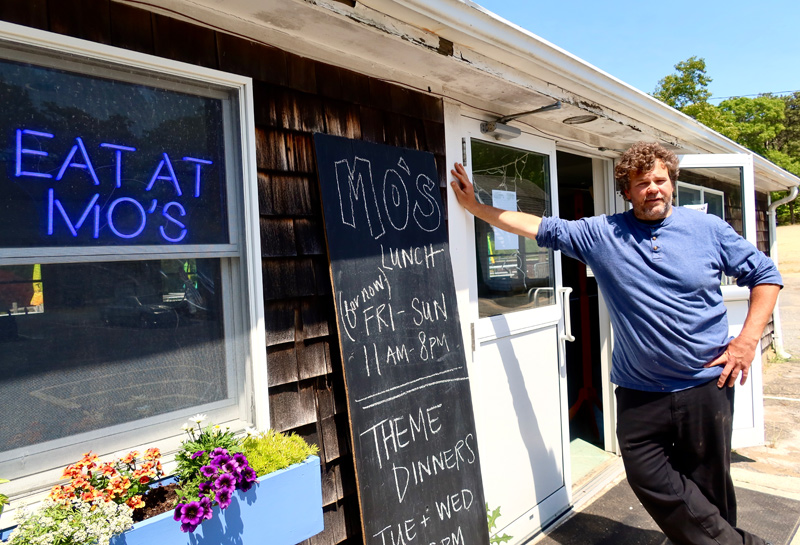
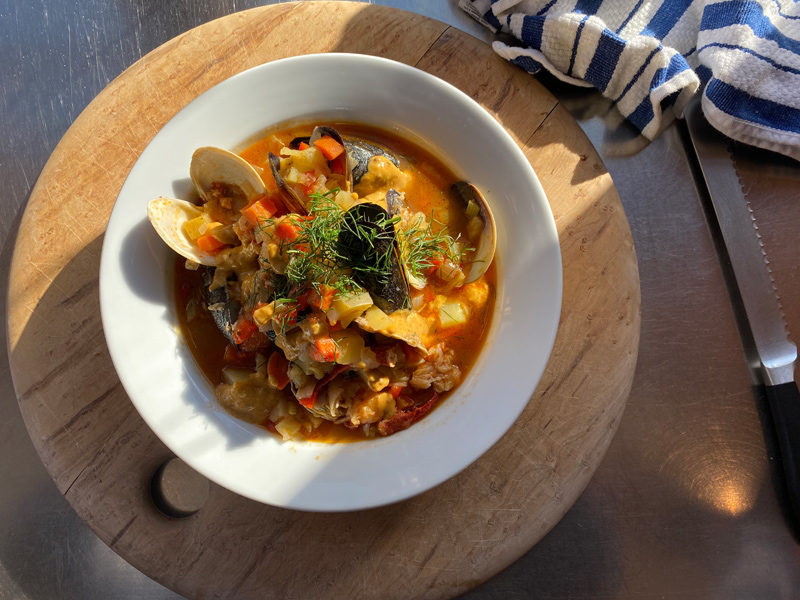
Date Night Bouillabaisse
This is my recipe for an all-shellfish bouillabaisse. It’s my little secret to impressing a date that leaves you with some great leftover items. In my opinion, having extra aioli and harissa paste in the fridge for a couple of days after is never a problem! This recipe can be taken in many different directions, but what I love about an all-shellfish bouillabaisse is that these ingredients are always fresh, locally sourced, and available at the fish market, and also surprisingly affordable. You can certainly add fish or scallops, or even shrimp if you want, but unless there is an allergy looming, never leave out the clams and mussels because they enhance the broth so much. This recipe may seem like a little much for the novice in the kitchen, but it’s made to impress by the fragrances in the kitchen and the delicious and outstanding presentation.
1 1-lb. lobster 2 Spanish onions 1 large bulb fennel 4-5 carrots, depending on size (about 1 lb.) 2 red bell peppers 1 jalapeño 2 stalks celery 2 heads garlic 1 Tbsp. cumin seed 2 Tbsp. coriander seed 2 Tbsp. paprika 2 Tbsp. salt 3 cups neutral oil (light olive oil or canola) 1 28-oz. can whole peeled tomatoes 2 Yukon Gold potatoes 2 egg yolks 1 lemon 1 lb. littleneck clams 1 lb. mussels 1 baguette
Preheat oven to 375°.
To start, break down the lobster by putting the tip of a knife directly through its head, then removing the tail by twisting, and removing each claw and knuckle (as a whole) from the body. Set these aside in a bowl in the fridge for a bit. Now pull the body in half, and scrape the tomalley and head matter out and discard (or save the tomalley, if you’re into that kinda thing). Using scissors, cut away the gills, the spongy part above the legs. Do not skip removing the gills. This is the difference between a lobster stock tasting aromatic and delicious or like a wet, fishy sponge. Add the body and legs to a heavy-bottomed Dutch oven with a bit of oil on medium heat, cover and slightly cook for 5-10 minutes.
Basically for this recipe, I like to have three things going at once. The lobster broth base cooking, a harissa paste roasting in the oven, and the vegetables for the final stew prepped in a bowl. While the lobster body parts are starting to cook, rough-chop one of the onions, half going in with the lobster, and the other half in a 10-inch cast-iron skillet or any pan around that size to roast in. This is going to be the harissa pan. Next, take the bulb of fennel and cut the long stems off, saving a few nice fronds. Cut these stems up and add to the lobster bodies. Cut the fennel in half and cut out the root part and any other stem off the top, and add this to the harissa pan. Cut the remaining fennel in half lengthwise, and then into ½-inch chunks. Add this to your vegetable prep bowl.
Peel and chop the carrots into 1-inch chunks, or whatever fun shape you’d like for the finished stew, and put this in your veg prep bowl. Add at least one carrot and whatever scrap cuts are left to each of the stock and the harissa pan. Deseed and ½-inch dice one of the bell peppers for the veg prep bowl, and rough-chop the other for the harissa pan. Deseed and rough-chop the jalapeño and add to the harissa pan. Dice celery to the same size as bell peppers, add to the veg prep bowl and set aside for a bit. Separate 8 cloves of garlic from heads, add 5 to the harissa pan, reserve 3 for aioli, and cut the remaining garlic heads in half and add to lobster stock. Add cumin seed, coriander, paprika, 2 tablespoons salt, and about ½ cup oil to the harissa pan. Toss around to coat, and roast in oven for 30-45 minutes, stirring occasionally. Add tomatoes to the lobster body, and break apart with a wooden spoon, stirring all the components around to get nice and coated with tomatoes. Cover and let cook for 10 minutes. Fill the tomato can about ¾ full with water, incorporating the residual juice, and add this to the stock. Let this simmer for 20 minutes.
Take a break. This was a lot. Clean up a bit, and think about how impressed your date is going to be when they walk in and smell all of the smells of this cooking.
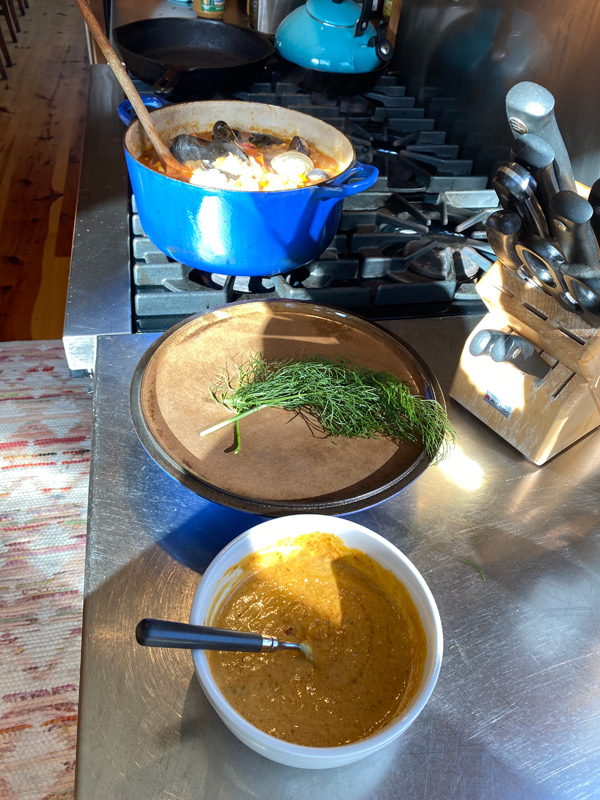
When ready to get back into it, add the lobster tail and claw/knuckles to the stock, cover, and let cook for 7 minutes. While these are cooking, cut potatoes, with skin on, into 1-inch dice, and cover with cold water.
Remove the lobster meat parts, and clean the knuckle and claw meat however you see fit. You can use either the back of a knife, a little fancy mallet, or I personally like to use some scissors, especially for the knuckle part.
Cut the tail in half lengthwise, with the shell still intact. Add any juices that accumulated to the stock. Strain the stock into a large bowl. I like to use just a colander set into a large bowl to let everything rest, press it real good, discard the shells/veggies and then strain through a finer strainer before pouring it into the final stew.
Wipe out the Dutch oven, and return to stove on medium-high heat with 2 tablespoons oil. Add prepped vegetables to pot, covered slightly, and let sweat for 10 min.
At this time, the harissa pan should be nice and toasty, and cooled off a little. Add everything in the harissa pan to a blender, and blend. It may need to be wetted with a touch more oil, and will most likely need to be scraped down a couple of times with a spatula. It is a paste, after all.
Put the paste away in a jar, leaving a bit in the blender for the aioli.
To make aioli: Add egg yolks to blender with the juice of one lemon, 3 cloves garlic, one tablespoon salt, and ¼ cup water. Blend for 2 minutes, and then slowly drizzle in two cups of oil. If the mixture gets too thick, stop the blender, add a few drops of water, scrape down the sides of blender, and then continue drizzling oil. Put some of this aioli in a serving dish with as much harissa as you like stirred into it, and reserve the rest for later use.
Add ¼ cup harissa to the sweating vegetables. Stir in drained potatoes, and let cook for 5 minutes with harissa. Add strained broth, and reduce heat to medium. Let this simmer for 10 minutes, or until potatoes are almost cooked all the way through. Add clams and simmer, covered, until open. Stir in mussels, add lobster meat on top, and cover for 2 minutes more, until mussels open. Give it all a good stir, and portion between two bowls with a hefty drizzle of the harissa aioli around, and a few of those reserved fennel fronds scattered on top. Toast up some thick slices of baguette and rub with harissa paste, and serve plenty on the side for sopping up all the delicious broth.
Chef Austin Racine
Austin was born and raised in central Virginia, moved here in 2001 and has been here year round ever since (except for a few winters away in Vermont and Puerto Rico). Chef and eventual owner of Moxie. Opened state road, beach road and nomans now starting “mo’s lunch” at the pa club making sandwiches, salads, snacks and themed take away dinners.
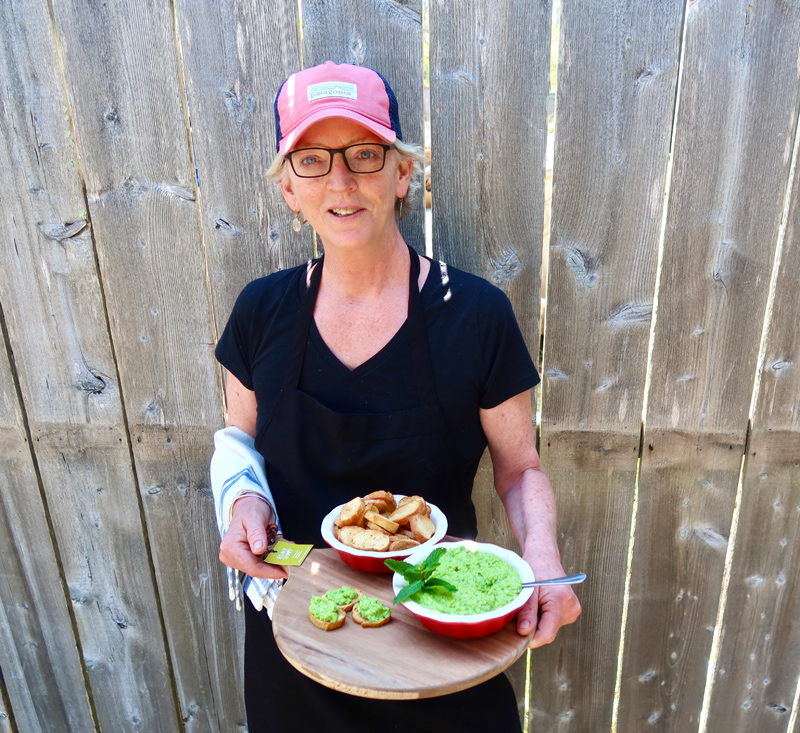
Spring Radish Spread
A riff on radishes and butter.
10 oz. radishes, trimmed and quartered 2 Tbsp. tarragon vinegar 5 Tbsp. butter softened (good butter is better) 1 tsp. horseradish 1 tsp. salt ½ tsp. fresh ground pepper
Process radishes in a food processor to a fine chop.
Soak radishes in vinegar for approximately 15 minutes. Drain well. Discard vinegar. Combine radishes with next four ingredients. Mix well.
Serve on toasted crostini!
Spring Pea Pesto
Great with salmon, and anywhere you would use pesto.
3 cups fresh or frozen peas (thaw peas if using frozen) 1 cup fresh basil ½ cup fresh mint ½ cup toasted nut of choice 1 Tbsp. fresh lemon juice ½ cup Parmesan cheese olive oil (start out with a half-cup of olive oil, adding more if needed) salt and pepper to taste
Process all ingredients, adding oil while running, to a smooth texture.
Chef Judy Klumick
Judy moved to MV from Vermont in 1997 and has fallen in love with fishing. Since 2014, Judy has created quite a following as a chef at Black Sheep, a gourmet take-away and marketplace at the airport.
508-338-7770, Blacksheepmv.com
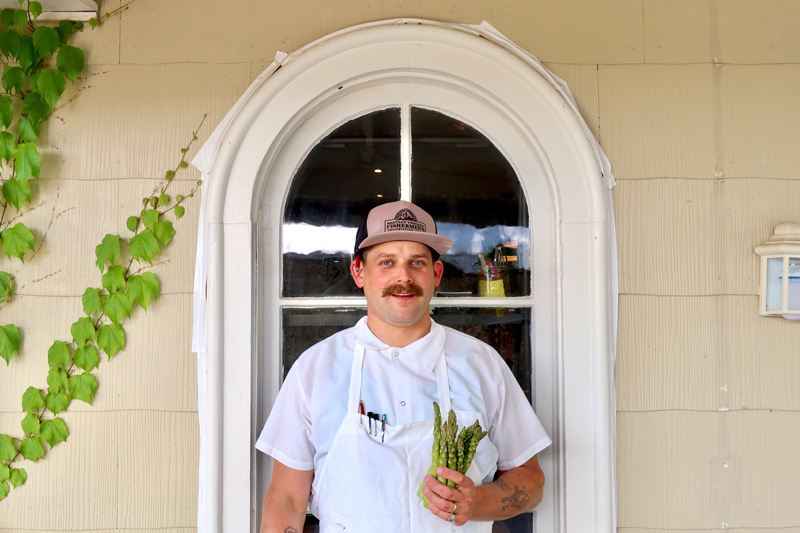

Shaved Asparagus Salad
1 bunch large asparagus (typically about a pound) 2 Tbsp. fresh, hand-torn mint 1 bunch red radish ½ cup English peas, blanched and shocked salt to taste 4 medium-size (2-oz.) balls of Burrata
Trim tough bottom part of the asparagus and discard. With a vegetable peeler, peel asparagus from top of the spear to the bottom, getting long, thin ribbons. Rinse and shave radish on a mandolin at a very thin setting, enough to keep a crispy texture in the salad.
Shuck fresh peas to get ½ cup. Have a pot of salted boiling water going, and an ice bath on hand. Blanch peas for about 30-45 seconds, and immediately transfer to ice bath.
Tear mint leaves, and toss all ingredients except for the burrata in a bowl.
Lemon-thyme vinaigrette
1¼ cup olive oil ¾ cup canola oil splash white wine vinegar 1 Tbsp. smooth Dijon mustard ¼ cup thyme, picked leaves 2 shallots, fine-diced
Add all ingredients to blender except for the olive oil. With the blender running on medium-high, slowly drizzle in olive oil until everything is emulsified. Season to taste with salt.
Lavender honey
1 cup honey ¾ cup dried lavender flowers
Place one ball of burrata in the center of each bowl. Arrange one handful of asparagus salad on top and around the burrata.
Drizzle desired amount of lemon-thyme vinaigrette over salad, then with a small spoon, lightly drizzle lavender honey over salad.
Chef Hal Ryerson
Hal Ryerson has been cooking professionally for nearly 20 years. From Cambridge to the Vineyard, to Providence, New York City and back to the island again. He owns the Sweet Life Cafe in Oak Bluffs with his wife, Erin. They live in Oak Bluffs with their two young children.

